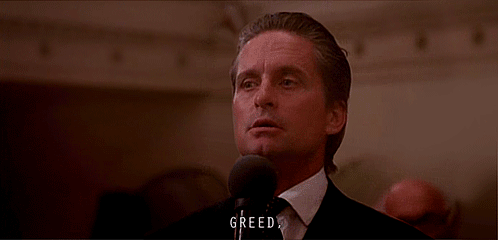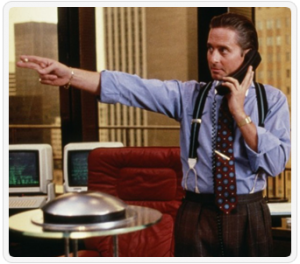In the immortal words of Gordon Gekko…

The point is, ladies and gentleman, that greed, for lack of a better word, is good. Greed is right, greed works.
Well then, when is greed too much for your contact lists and when is the line crossed that enough is too much?
As an email consultant, one of the most common questions I receive from new and potential clients is, “How often is too often to send?”
If you simplified email marketing campaigns into their most basic elements, you as the marketer are looking for the highest level of engagement from your contacts. The more opens and clicks, the further down your contacts go in the buying process. If you can push as many contacts far enough down the buying road your revenues and ROI will go up. So why isn’t unlimited email frequency a standard business practice?
Simply put, because consumers have the right to Unsubscribe. They can actively vote if your communications are worthy of their time and attention. If you have developed your email list organically, then you know your contacts want to receive information from you. It is important to not abuse this position of respect from the consumer by betraying their trust and overwhelming them to the point of annoyance. There needs to be a balance between their interest and your passion for conversion.
The purpose of the next three tips is to help guide you along the road of partnership and not down the road of “The Unsubscribe”.
Frequency
 Like the majority of marketing variables, frequency is dependent on the product or service you provide and where the contact is in the sales cycle. Is your product a daily or weekly purchase? Do you sell groceries, lottery tickets, and fast food? If so, your frequency can be very high as long as you are providing valuable content and information to your contacts.
Like the majority of marketing variables, frequency is dependent on the product or service you provide and where the contact is in the sales cycle. Is your product a daily or weekly purchase? Do you sell groceries, lottery tickets, and fast food? If so, your frequency can be very high as long as you are providing valuable content and information to your contacts.
I love Jersey Mike’s, if they sent me a $5 off coupon everyday it is conceivable that I might eat their sandwiches Monday through Friday for lunch (until I am inevitably bored with the #9 and must move on).
If your company has a complex and long sales cycle, using email to walk them through the buying process is a great technique. Use emails to contact your consumers after they have reached a key step or benchmark within the process. Instead of guessing when you should send a communication, let the contact determine what their next steps are and let email be their guide along the way.
If your business falls into the remaining 95% of companies out there, use your email reporting to determine how much is too much. Vary and test the frequency of your communications and let the stats drive your strategy. Are your contacts opening less and less the more you send? Are your unsubscribes doubling with your increased frequency? Keep a close eye on your email statistics and be responsive to their changes.
Content
 More is definitely not better when it comes to email content. I have seen so many examples of organizations that put together endless email copy, highlighting a never ending list of news, products, sponsors, contacts, etc. Extensive email content is bad form for many reasons. Consumer attention is limited, we have all seen the statistics of how inundated we are all with marketing. Cutting through the clutter with a concise targeted message will always have better results than a long-winded generic snooze fest.
More is definitely not better when it comes to email content. I have seen so many examples of organizations that put together endless email copy, highlighting a never ending list of news, products, sponsors, contacts, etc. Extensive email content is bad form for many reasons. Consumer attention is limited, we have all seen the statistics of how inundated we are all with marketing. Cutting through the clutter with a concise targeted message will always have better results than a long-winded generic snooze fest.
Your goal should be to drive consumers from your email to your website since only so much can be accomplished within the email body. If your company has a lot to say, highlight the concepts using email and then drive the consumer to your website where they can explore and continue their informational adventure.
Just make sure you have clear “Call to Actions” to drive conversion and response along their way.
List Size
I know nothing feels better than to see how humongous your list is getting. Even I, take pride in building my own internal lists. There is something to be said to having more contacts then you did the day before. However, more is not always better. You really must consider the quality of your new contacts. Someone requesting product information is infinitely more valuable than a three year old contact that you do not remember obtaining. Understanding the unique segments of your customer base and the types of communications they want to receive, will allow you to hyper target your message and really move the needle when it comes to your brand and your business.
Conclusion
If you’re not inside – you’re outside.
– Gordon Gekko
Respect your contacts. They are more than just an email or name. Your contacts are people, they are fans, they could be customers, and most importantly can be brand ambassadors. Treat your contacts with the respect they deserve and be responsive to their needs. If you focus on who, what, and when, you send them communications you will never need to worry about how much is too much.

